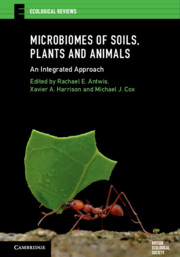Book contents
- Microbiomes of Soils, Plants and Animals
- Ecological Reviews
- Microbiomes of Soils, Plants and Animals
- Copyright page
- Contents
- Contributors
- Preface
- Abbreviations
- Chapter One Microbiomes of soils, plants and animals: an introduction
- Chapter Two Analytical approaches for microbiome research
- Chapter Three Microbiomes of soils
- Chapter Four Factors that shape the host microbiome
- Chapter Five Microbial symbioses and host nutrition
- Chapter Six The microbiome and host behaviour
- Chapter Seven Host microbiomes and disease
- Chapter Eight Adapting to environmental change
- Chapter Nine Microbial biotechnology
- Chapter Ten Synthesis and future directions
- Index
- Plate Section (PDF Only)
- References
Chapter Five - Microbial symbioses and host nutrition
Published online by Cambridge University Press: 07 March 2020
- Microbiomes of Soils, Plants and Animals
- Ecological Reviews
- Microbiomes of Soils, Plants and Animals
- Copyright page
- Contents
- Contributors
- Preface
- Abbreviations
- Chapter One Microbiomes of soils, plants and animals: an introduction
- Chapter Two Analytical approaches for microbiome research
- Chapter Three Microbiomes of soils
- Chapter Four Factors that shape the host microbiome
- Chapter Five Microbial symbioses and host nutrition
- Chapter Six The microbiome and host behaviour
- Chapter Seven Host microbiomes and disease
- Chapter Eight Adapting to environmental change
- Chapter Nine Microbial biotechnology
- Chapter Ten Synthesis and future directions
- Index
- Plate Section (PDF Only)
- References
Summary
All multicellular organisms, be they heterotroph or autotroph, saprophyte or detritivore, herbivore or carnivore, harbour a distinct microbiome that is adapted to aid the flow of nutrients to its host. Often these symbioses have a long evolutionary history. This microbially mediated release of nutrients has implications for host health at the organismal scale, as well as environmental turnover and regulation of nutrient cycles on the global scale. Classic examples of plant–soil nutrient dynamics include symbiotic nitrogen fixation by rhizobia and Frankia spp. in leguminous and non-leguminous species, respectively, and the mycorrhizal symbioses that facilitate the release of phosphorous for plants by fungi in return for carbon produced via photosynthesis. A number of invertebrate–microbe symbioses have also been studied in detail, including aphids and nutrient-fixing symbionts, fungal gardens of leafcutter ants and termites, and honeybees and pollen digestion. We provide an overview of these here, in addition to the interactions between gut microbes and nutrition in vertebrates, particularly humans and agriculturally important species.
Keywords
- Type
- Chapter
- Information
- Microbiomes of Soils, Plants and AnimalsAn Integrated Approach, pp. 78 - 97Publisher: Cambridge University PressPrint publication year: 2020
References
- 1
- Cited by

